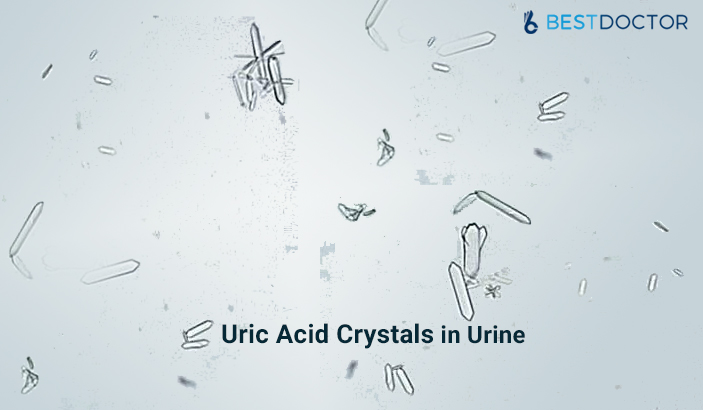Uric acid crystals in the urine are found in various shapes but commonly occur in rhomboidal shape. They are caused due to various reasons such as a change in urine pH and urine volume. Diagnosis is done through urinalysis or imaging techniques. Treatment options include urinary alkalizer, surgical intervention, and diet restriction.
What Are The Causes Of Uric Acid Crystals In Urine?
Probable causes of uric acid crystals in urine are;
1. Change In Urine PH
The normal urine pH ranges from 4.5 to 8 with an average value of 6. Change in urine pH promotes the formation of crystals because of changes in solubility and resulting precipitation. The risk of developing uric acid crystals increases with a reduction in pH value. People with acidic urine (pH< 5.4-5.8) are more prone to the formation of uric acid crystals in urine.
2. Dietary Habits
Various dietary habits also increase the risk of getting uric acid crystals in urine. Food rich in high protein increases the risk of uric acid crystal formation in two ways. First, it increases the concentration of uric acid. Second, it makes the urine more acidic. Both these contribute to the development of uric acid crystals.
3. Dehydration
Poor hydration status also increases the risk of uric acid crystals in the urine. This is due to the increased concentration of uric acid in the urine leading to precipitation.
4. Underlying Medical Conditions
Underlying medical conditions also play an important role in the development of uric acid crystals. The incidence of hyperuricemia increases during seizures. This is due to the increased breakdown of ATP due to repetitive muscle contraction.
How The Uric Acid Crystals In Urine Diagnosed?
Uric acid crystals can be diagnosed through the following methods;
1. Imaging Evaluation
Various imaging techniques are used to diagnose the uric acid crystals. The target of the physician is to differentiate between crystals formed due to different compounds. As uric acid crystals do not contain any heavy atoms such as calcium, they are poorly evaluated through X-ray. Measurement of radiographic density through a CT scan provides better differentiation of uric acid crystals from crystals of other compounds.
2. Urinalysis
High level of uric acid in urine possesses significant risk for crystal formation. These high levels can be diagnosed through urinalysis. It is always advised to Ask a nephrologist who is most experienced to get better treatment. Many times, before the formation of crystals, symptoms of increased uric acid levels in the body are experienced by the patient.
What Is The Clinical Association Of Uric Acid Crystals In Urine?
Uric acid crystals are generally formed due to the high level of uric acid in the body. Various medical conditions result in an increased level of uric acid in the body. These includes;
1. Genetic Abnormalities
Metabolism of various chemicals are regulated through genes. Any abnormality in these genes may alter the metabolic process of carbohydrates, proteins or fats resulting in abnormal levels of various substances including uric acid.
2. Kidney Disease
Kidneys are the primary organs through which uric acid is removed. Any problem in the kidney may result in poor excretion of uric acid. This will raise the level of uric acid in the body.
3.Systemic Disorders
Various systemic disorders reduce the pH of urine thereby increasing the risk of uric acid crystal formation in urine. These conditions include diabetes, obesity, and hypertension.
4. Intestinal Disorders
Uric acid secretion is increased by kidneys when there is an imbalance in buffer homeostasis. This imbalance may be caused due to significant loss of biphosphate buffer due to diarrhea.
What Are The Treatment Options For Uric Acid Crystals In Urine?
Various strategies are formulated to dissolve uric acid crystals. These strategies include;
1. Urinary Alkalizer
Increasing the pH of urine through urinary alkalizer is the primary treatment to dissolve uric acid crystals. In the case of uric acid crystals in urine in the child or uric acid crystals in urine in infants, along with acute renal failure, dialysis and administration of allopurinol are also recommended.
2. Surgical Intervention
In the case of large uric acid crystals, surgical intervention is required. Surgical therapy includes extracorporeal shock wave lithotripsy, percutaneous nephrolithotomy, and ureteroscopic stone extraction.
3. Diet Restrictions
Diet recommendations and restrictions are also an important part of the treatment regimen. The patient should be advised to have a low purine diet. The patient should avoid or maintain a low intake of peas, spinach, asparagus, beans, and sweetbreads.
How To Prevent Occurence Of Uric Acid Crystals In Urine?
People who have a history of getting uric acid crystals in the urine are at high risk of recurrence. The following may help to minimize the risk:
1. Hydration
Maintaining a healthy hydration level reduces the concentration of uric acid and reduce the risk of crystal formation.
2. Diet Restriction
Avoid or restrict taking a diet rich in purine.
3. Manage Systemic Diseases
Systemic diseases such as hypertension, obesity, and diabetes should be kept under control.
4. Scheduled Health Check-ups
Have a blood or urine analysis to keep an eye on kidney function.

Rohit Jain is an IPR Specialist and Medical Content Writing Expert. For over a decade, he has written several articles in the areas of female infertility, Erectile dysfunction, hemangioma, cervical cancer, monoclonal gammopathy of undetermined significance, mononucleosis, mitral valve disorder, shin splints, mild cognitive impairment, cellulitis, lymphoma, sepsis, cardiac rehabilitation and more.








16 Warning Signs You Need to Go See Your Doctor As Early As Possible
Gastroparesis: Symptoms, Causes, Diagnosis, Treatment, and Life Expectancy
Does Melatonin Help You Sleep? An In-Depth Analysis
Navigating Sexual Health Online: When to Consult a Sexologist